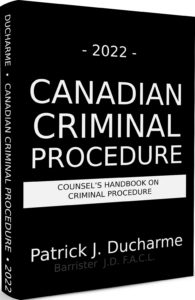 |
| Patrick J Ducharme |
Credible or trustworthy evidence is referred to in subsection 518(e) of the Criminal Code in relation to evidence admissible at bail hearings. For at least forty years the same words have been interpreted in a specific way dealing with the important issue of one’s liberty. There is no reason to think Parliament, in enacting subsections 540 (7)-(9), believed that this terminology would be given any different meaning now.
In R. v. Powers, Lerner J. defined the term “credible or trustworthy” as a relaxation of the rules of evidence applied at trial, making hearsay evidence admissible, “so long as each party has a fair opportunity of correcting or contradicting any statement or evidence he considers prejudicial to his position.”2 In doing so, Lerner J. relied upon similar reasoning in Re Vergakis3 finding credible or trustworthy evidence admissible so long as the person affected by the credible or trustworthy evidence is given an opportunity to be heard and given a fair opportunity for correcting or contradicting any relevant statement prejudicial to the person’s position.
Because the term “credible or trustworthy” has been used for years in relation to bail such that its meaning is settled in law, there is no reason to believe that the use of this terminology for preliminary inquiries should or will be treated any differently. Barr J. in R. v. Hajdu5 found that Crown counsel was not permitted to read into the record the evidence on a bail hearing unless there is a specific agreement to do so between the Crown and defence. When there was no agreement, the Crown was required to produce some evidence that allows the defence to challenge the evidence of the Crown.
In R. v. Woo6the accused brought an application for bail review on a charge of trafficking in cocaine. The order of detention was made on the strength of statements made by the Crown, but the Crown tendered no evidence. The Justice at the bail hearing relied upon the Crown’s statements. The court held that the accused had not justified his release. The accused had provided the court with information that he was thirty-eight years old and married with one child, and, that he and his wife owned their home in which they had $200,000 equity. He owned and operated a business that employed six to eight persons. He also produced impressive letters of reference that were tendered on his behalf.
Fraser J. in dealing with the issue of credible or trustworthy evidence wrote the following:
I do not see any conflict among West, Hajdu and Dhindsa. They arrived at this result:
1. Where Crown counsel and defence counsel agree as to matters of fact, those facts may be presented to the court by means of statements of counsel.
2. Where counsel do not agree as to matters of fact (where, in the words of Dhindsa, there is “controversy or contradiction”, evidence must be tendered.
3. If evidence is required, it sometimes may be presented in affidavit form and may include hearsay.
Consequently, while subsection 518 (1) (e) entitles the Justice at a bail hearing to act on hearsay evidence considered credible or trustworthy, it is not authority for Crown counsel to simply read a statement of the circumstances of the offence, a procedure which deprives the accused of his right to cross-examine.
Re Vergakis was an immigration case. Immigration cases have for years also used the same phrase “credible or trustworthy evidence.” The Immigration and Refugee Protection Act provides that the Board may receive evidence it considers credible or trustworthy. The Federal court has treated “credible” and “trustworthy” as having the same meaning: “credible.”
Consequently, the words ‘credible or trustworthy’ signify a relaxation of the rules of evidence to permit otherwise inadmissible hearsay evidence provided the accused in criminal matters or the opposing party in administrative matters is given an opportunity to be heard and given a fair opportunity for correcting or contradicting any relevant statement prejudicial to her position.

The above is the an excerpt of Patrick J Ducharme's book, Canadian Criminal Procedure, available at Amazon or in bulk through MedicaLegal Publishing along with Criminal Trial Strategies.
Subscribe to Patrick Ducharme's Youtube Channel
